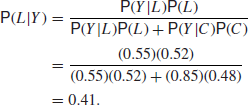1.2 Examples on Bayes’ Theorem
1.2.1 The Biology of Twins
Twins can be either monozygotic (M) (i.e. developed from a single egg) or dizygotic (D). Monozygotic twins often look very similar and then are referred to as identical twins, but it is not always the case that one finds very striking similarities between monozygotic twins, while some dizygotic twins can show marked resemblances. Whether twins are monozygotic or dizygotic is not, therefore, a matter which can be settled simply by inspection. However, it is always the case that monozygotic twins are of the same sex, whereas dizygotic twins can be of opposite sex. Hence, assuming that the two sexes are equally probable, if the sexes of a pair of twins are denoted GG, BB or GB (note GB is indistinguishable from BG)
![]()
It follows that
![]()
from which it can be seen that
![]()
so that although it is not easy to be certain whether a particular pair are monozygotic or not, it is easy to discover the proportion of monozygotic twins in the whole population of twins simply by observing the sex distribution among all twins.
1.2.2 A political example
The following example is a simplified version of the situation just before the time of the British national referendum as to whether the United Kingdom should remain part of the European Economic Community which was held in 1975. Suppose that at that date, which was shortly after an election which the Labour Party had won, the proportion of the electorate supporting Labour (L) stood at 52%, while the proportion supporting the Conservatives (C) stood at 48% (it being assumed for simplicity that support for all other parties was negligible, although this was far from being the case). There were many opinion polls taken at the time, so we can take it as known that 55% of Labour supporters and 85% of Conservative voters intended to vote ‘Yes’ (Y) and the remainder intended to vote ‘No’ (N). Suppose that knowing all this you met someone at the time who said that she intended to vote ‘Yes’, and you were interested in knowing which political party she supported. If this information were all you had available, you could reason as follows:

1.2.3 A warning
In the case of Connecticut v. Teal [see DeGroot et al. (1986, p. 9)], a case of alleged discrimination on the basis of a test to determine eligibility for promotion was considered. It turned out that of those taking the test 48 were black (B) and 259 were white (W), so that if we consider a random person taking the test
![]()
Of the blacks taking the test, 26 passed (P) and the rest failed (F), whereas of the whites, 206 passed and the rest failed, so that altogether 232 people passed. Hence,
![]()
There is a temptation to think that these are the figures which indicate the possibility of discrimination. Now there certainly is a case for saying that there was discrimination in this case, but the figures that should be considered are
![]()
It is easily checked that the probabilities here are related by Bayes’ Theorem. It is worth while spending a while playing with hypothetical figures to convince yourself that the fact that ![]() is less than
is less than ![]() is irrelevant to the real question as to whether
is irrelevant to the real question as to whether ![]() is less than
is less than ![]() – it might or might not be depending on the rest of the relevant information, that is on
– it might or might not be depending on the rest of the relevant information, that is on ![]() and
and ![]() . The fallacy involved arises as the first of two well-known fallacies in criminal law which are both well summarized by Aitken (1996) (see also Aitken and Taroni, 2004, and Dawid, 1994) as follows:
. The fallacy involved arises as the first of two well-known fallacies in criminal law which are both well summarized by Aitken (1996) (see also Aitken and Taroni, 2004, and Dawid, 1994) as follows:
Suppose a crime has been committed. Blood is found at the scene for which there is no innocent explanation. It is of a type which is present in 1% of the population. The prosecutor may then state:
‘There is a 1% chance that the defendant would have the crime blood type if he were innocent. Thus, there is a 99% chance that he is guilty’.
Alternatively, the defender may state:
‘This crime occurred in a city of 800,000 people. This blood type would be found in approximately 8000 people. The evidence has provided a probability of 1 in 8000 that the defendant is guilty and thus has no relevance.’
The first of these is known as the prosecutor’s fallacy or the fallacy of the transposed conditional and, as pointed out above, in essence it consists in quoting the probability ![]() instead of
instead of ![]() . The two are, however, equal if and only if the prior probability
. The two are, however, equal if and only if the prior probability ![]() happens to equal
happens to equal ![]() (E), which will only rarely be the case.
(E), which will only rarely be the case.
The second is the defender’s fallacy which consists in quoting ![]() without regard to
without regard to ![]() . In the case considered by Aitken, the prior odds in favour of guilt are
. In the case considered by Aitken, the prior odds in favour of guilt are
![]()
while the posterior odds are
![]()
Such a large change in the odds is, in Aitken’s words ‘surely of relevance’. But, again in Aitken’s words, ‘Of course, it may not be enough to find the suspect guilty’.
As a matter of fact, Bayesian statistical methods are increasingly used in a legal context. Useful references are Balding and Donnelly (1995), Foreman, Smith and Evett (1997), Gastwirth (1988) and Fienberg (1989).
